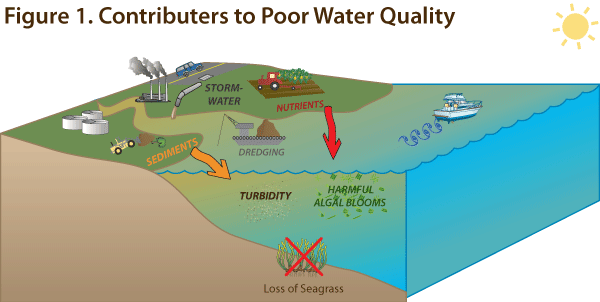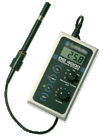 |
Water quality is simply the measurement of the ecological health of water compared to a set of standards. Water quality parameters for marine and estuarine systems include: |
|||
|
|
 |
|
One of the most significant threats to seagrasses is the reduction of light, i.e. light attenuation, by the water column and its components. Because of this, the parameters related to the amount of light penetration would likely be considered the most important to seagrass health, including nutrients, chlorophyll a, turbidity, TSS, and color of water. Temperature is also critical to seagrasses, especially eelgrass (Zostera marina), which thrives in cold water. Drastic salinity fluctuations can also cause severe distress in seagrasses.
Stressors Nutrients, especially nitrogen, are needed at the roots and can be limiting for seagrass growth and productivity (Short et al 1995), but excess nutrients can be toxic. Excess nutrients in the water column can cause a slew of problems for seagrasses. Eutrophication is considered to be the most widespread cause of seagrass decline. In this process, the introduction of nutrients like nitrogen and phosphorus to the water column promotes excessive growth of phytoplankton and epiphytic algae which blocks the light needed by seagrasses. In seawater, N and P most often occur in the form of nitrate, ammonium, and phosphate. The most common sources of these nutrients include sewage effluent, septic system seepage, stormwater outfalls, as well as domestic, industrial and agricultural runoff. Though water can be tested directly for nutrient concentrations, most often the concentration of chlorophyll a is used because it measures the amount of phytoplankton present in the water column, which indicates the availability of excess nutrients. Contaminants such as heavy metals, herbicides, biocides (used on ship hulls), pesticides, and petroleum products can negatively affect seagrasses, though further study is needed in these areas. Seagrasses have been found to bioaccumulate toxins such as herbicides and metals, which would be harmful to grazers and the species that consume them. Heavy metals are known to disrupt photosynthesis, but detoxification can occur if the source of metal exposure is removed. Exposure to petrochemicals causes a reduction in tolerance to other stresses. Temperature and salinity are included in water quality parameters, but we designated each of these their own page. Go to Temperature or Salinity page… |
|||
| Data Collection |  |
 |
 |
Some water quality parameters are relatively easy to measure and only require fairly inexpensive equipment, such as temperature, salinity, pH and nutrients (using test kits), and Secchi depths. Volunteers can assist with collecting this type of water quality data. Collecting data consistently and over a long period of time can become expensive and time consuming though, so the use of loggers that can be left on site is the most efficient way to collect data. Some parameters, like TSS and DOC, can’t be performed on site, requiring lab analysis. Ongoing monitoring of water quality is typically conducted by government agencies, and is often available for use in research and monitoring. Navigational buoys are often used by the U.S. Coast Guard, NOAA, and others as attachment sites for loggers, and this information is also available to the public. Using satellite technology, this data is acquired and made available in real time. This type of technology has enormous potential for long-term water quality and seagrass monitoring. CCE conducts long-term monitoring of eelgrass for the Peconic Estuary Program which includes water quality data from the Suffolk County Health Department. We deploy temperature loggers at each monitoring station that can be left on site for years and can record many readings per day if necessary. Eelgrass density counts and other observations are recorded yearly. Learn more about eelgrass monitoring…
|
|||
Goals (CCMP)
|
|||
HOME ~ CONTACT US ~ ABOUT OUR PROGRAM ~ CCE SUFFOLK COUNTY HOME
© 2012 www.SeagrassLI.org / Cornell Cooperative Extension Marine Program